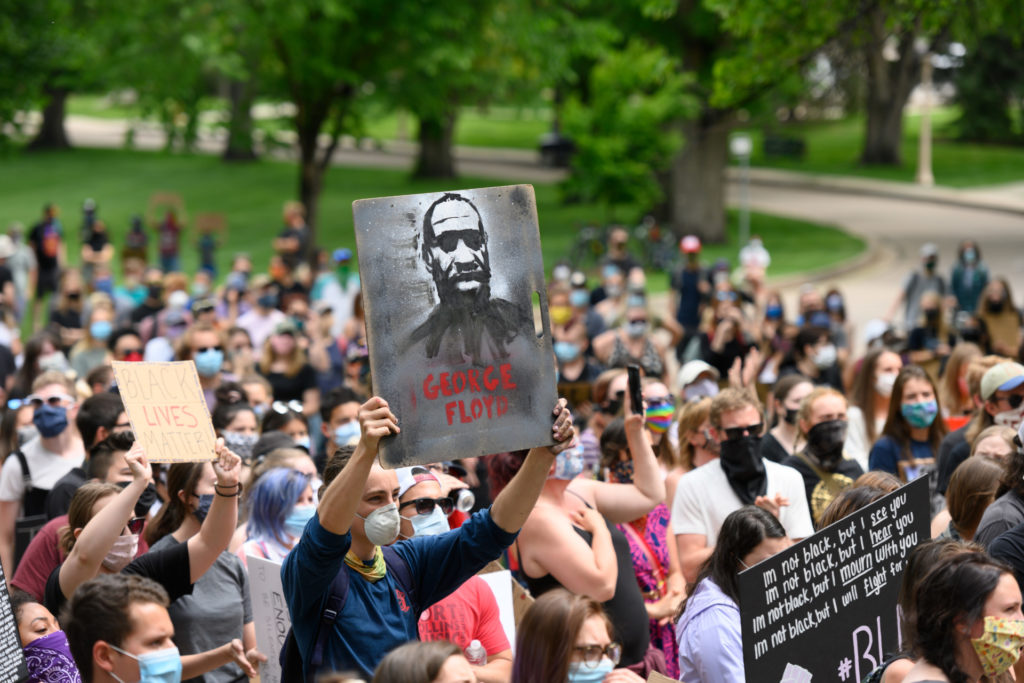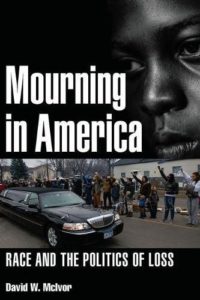
By David W. McIvor, Associate Professor, Political Science
Dr. McIvor is the author of “Mourning in America: Race and the Politics of Loss.”
When the protests started in the streets of Denver last spring, days after George Floyd was killed in Minneapolis, I watched dozens of people marching with anguish and affliction on their faces. Several of them were crying, or clearly had been. When I watched the video of the final moments of Mr. Floyd’s life, I myself felt the telltale symptoms of grief: a clenched stomach; a surge of adrenaline; and an overwhelming sense of powerlessness.
As they unfolded over the next days and weeks, the protests seemed like a moment when Black grief — a feeling familiar for Black Americans after the killings of Ahmaud Arbery, Trayvon Martin, Emmett Till and so many others — might finally become collective grief for the rest of America. The crowds were multiracial, united, emotive, insistent. They marched night after night, giving the unfolding events of last May and June a dreamlike quality, magnified by the fact that they took place in the similarly surreal days of Covid-19 lockdowns. It was a time full of unexpected surprises (Minneapolis said it would dismantle its Police Department?!), deep uncertainty (can it do that?!) and wild swings between hope and anguish, possibility and anxiety.
Maybe it was just a moment, though, a brief disruption of a relatively unchanging situation. Violence against Black lives has continued since the day Mr. Floyd was murdered. Meanwhile, the brief and striking shift in public opinion toward the Black Lives Matter social movement steadily declined, especially among white Americans. Political debate and partisan identities have returned to their familiar polarized pattern. Popular discourse once again largely dissociates from Black pain. One year later, it is easy to be cynical about this moment of collective grief.
But there is another way of thinking about this — that it is still possible to build on the moment of shared grief over the death of George Floyd, in order to see a way toward a more democratic and just coexistence.
There is an intimate yet still unexplored relationship between mourning and democracy. We tend to see mourning as a temporary disruption of “normal” life — a cycle of pain, denial and eventual acceptance. This picture is both right and wrong. Mourning is a movement toward wholeness by way of acknowledging brokenness. But it is less a terminable process than a way of being in the world.
To see this better, we have to appreciate the role that attachment and ambivalence play in mourning.
Mourning implies attachment. We mourn only for those to whom we are connected, or for that to which we are committed. In the case of George Floyd, who became a public figure only through his death, the communal mourning that followed was less about the specific life that was lost than the democratic ideals that were so clearly violated: the right to life, liberty and the pursuit of happiness that was extinguished for Mr. Floyd and for too many others. Public mourning, then, is the expression of grief when the longing for social recognition and equal justice is unrequited.
Mourning also confronts us with an experience of ambivalence: It is a pivot between life and death, past and future, love and hatred, openness and defensiveness, and reparation and destruction. A democratic politics of mourning implies not only the clarification of our public ideals and commitments — our civic attachments — but also a wrestling with the ambivalence in American history and Americans’ psyches. Mourning is the work not only of integrating what has been lost into our personality, but also of integrating the personality itself: our fears and our hopes, our vulnerabilities and our power. To do this, we first have to overcome the defenses that dissociate us from the pain of loss — our own pain and that of others.
Often in times of grief, narratives of innocence and immorality — of absolute good and abject evil — deflect or defend against an experience of ambivalence. Instead of a complex picture of identity and history that might inspire dialogue and collaborative action, the raw energy of mourning is channeled through the quick and relatively easy identification of scapegoats or magical fixes.
But public mourning can also manifest something different, precisely because it can open up a dreamlike space of possibility. This is what the psychoanalyst Dr. D.W. Winnicott called “potential space.” For Dr. Winnicott, cultural activities — like a protest, although he did not use that example — are both real and surreal. They take place in the realm of shared reality, but they are not reducible to this reality because they are also imbued with aspects of dreaming, such as free association, playful juxtaposition and a fluid sense of time. It is the dreamlike nature of cultural life that makes creativity possible — what Dr. Winnicott linked to play. Following Dr. Winnicott, we can see mourning as a space where we acknowledge loss and ambivalence by playing with the possibilities for different, more creative responses to loss.
This brings me back to the George Floyd protests.
The initial protests occurred in potential space — a mixture of dream and reality — and despite the resumption of familiar discourses in their wake, there are signs that new possibilities have emerged from that moment. For example, there is the notable spike of interest in “truth and reconciliation” processes and racial equity initiatives. The Divided Community Project at The Ohio State University recently published a practical guide for such initiatives, which could take place in networks of civic associations, within school districts or at municipal, state or national levels. (Disclosure: I was a consultant on this project.) Such projects could help counter typical social defenses against grief.

No doubt any such efforts would be imperfect. But they would also represent tentative steps into a democratic work of mourning, with unknown consequences. What we do know is that conversations across social difference can result in greater levels of understanding and trust. We have a proof of concept, but we lack larger structures or rituals of this kind of work. Yet a hunger for these labors clearly exists, which can be built upon.
What would happen if we thought creatively about how to mourn as a society? George Floyd’s story is inseparable from his tragic death, and any commemoration should not shy away from that fact. So one possibility would be to make May 25 — the day Mr. Floyd was murdered — a day of both public commemoration and reflection. It could help highlight the ongoing dysfunctions of American democracy while creating opportunities for public dialogue and public work. It could be a day of protest and service, in light of America’s tragic history and its continuing challenges of violence, disrespect and unequal access to liberty.
May 25 could become a day of public mourning, understood as a space for sharing not just grief about the present world but also aspirations for a world that Americans could build together. A day of mourning would open up potential spaces in American politics — even if momentarily — and recapture some of the dreamlike quality of that brief time when, after Mr. Floyd’s murder, another world seemed possible.